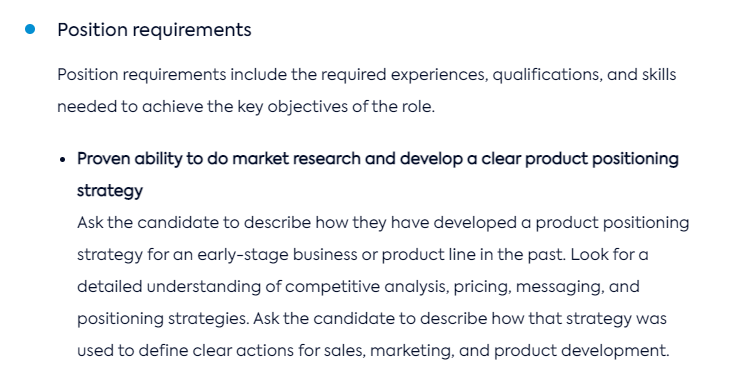A 3-step guide to behavioral interviewing success
Ott Niggulis
The end goal of any hiring process is to find candidates whose knowledge, skills, and behaviors match a particular role and personality and values match the company and the team.
The primary tool for figuring all of this out is interviewing. The problem is that traditional interviews can quickly turn into free-flowing conversations lacking structure and clear goals. As such, a traditional interview is not a great tool for assessing candidate match.
This is not to say that candidate interviews, as a whole, are bad. What’s needed is a different approach to interviewing - a more behavioral approach.
What is behavioral interviewing?
Behavioral interviewing is a method of interviewing that focuses on a candidate's past behavior and experiences. Candidates are asked to provide specific examples from past employment showcasing competencies and behavioral patterns that you’re looking for in a given role.
The aim is to understand how candidates have acted in situations likely to arise in the new role. Candidate answers to behavioral questions should provide verifiable evidence of how they have dealt with a similar issue in the past.
With behavioral interviewing, candidates are asked to provide specific examples from past employment.
Behavioral interviews fall under the broader category of structured interviewing. Structured interviews follow a predetermined set of specific job-related questions , evaluate each question with an agreed rating scale, and use the same basic questions for all candidates.
This allows hiring managers to objectively compare candidates based on their evaluated results and choose candidates that truly best match what the company is looking for.
To learn more about Wisnio and how we can help you build high performing teams, sign-up for a free account here.
Step 1 - Analyse the job

Example Position Requirement for a Head of Marketing (SaaS) role
The first step is to analyse the job opening to understand the kind of behaviors along with the required experiences, qualifications, and skills needed to achieve the key objectives in the role.
For judging and understanding behaviors, one of the best ways is to use a competencies-based approach.
Competencies are the knowledge, skills, and abilities required to perform a job successfully. In most cases, a few core competencies differentiate top performers in a given industry and job function.
Systematically defining a job's critical competencies and evaluating candidates' based on those competencies is the most objective way to shortlist candidates. Doing so brings clarity to the early stages of the hiring process, where the potential for ambiguity and bias is highest.
Competencies are the knowledge, skills, and abilities required to perform a job successfully. In most cases, a few core competencies differentiate top performers in a given industry and job function.
Based on the role, hiring managers can choose the competencies best suited for the role and use them as the basis for behavioral interview questions.
For example, people with Interpersonal Understanding understand the unspoken or partly expressed feelings, goals, and needs of others, and can relate to culturally diverse groups of people.
While a person with Attention to Detail manages information to reduce uncertainty in the surrounding environment and is driven to ensure order, quality, and accuracy.
You can develop your own competency library (many companies have) or use a ready-made library of competencies to choose from. At Wisnio, we use a library of 20 competencies based on research by Spencer and Spencer.

Example competencies from the Wisnio competency library.
Step 2 - Interview questions
After analysing the job opening, you end up with a list of requirements and competencies that candidates need to fulfil. The next step is coming up with methods to assess those.
With some, for example, prior work experience or professional qualifications, the assessment is easy. The candidate either has the needed work experience or professional qualifications or not. For others, like competencies, things are a little more complicated.
As the aim is to understand a candidate's past experience and actions in similar situations, the questions have to be worded to make it easy for the candidates to, in essence, tell a short story about a similar experience.
There are many ways to construct behavioral interview questions with one approach - the STAR model, being especially popular.

The STAR model of behavioral interviewing
STAR stands for Situation, Task, Action, Results, and it helps candidates by encouraging them to answer with a short story about past behavior.
Situation: What was the situation the candidate was in?
Task: What was the task the candidate needed to accomplish?
Action: What were the actions the candidate took to accomplish this task?
Results: What were the results of these actions?
Example:
- Situation - “Give an example of a time when you...”
- Task - “competed for resources at work.”
- Action - “How did you make your case?”
- Results - “Were you successful?”
Taken together, the question reads “Give an example of a time when you competed for resources at work. How did you make your case? Were you successful?”
Wording the questions this way makes it easier for candidates to understand what exactly they are being asked and it provides an easy to follow guide on how to answer.
Another example:
- Situation - Give an example of a time when you...
- Task - offered advice to a colleague who did not directly ask for help.
- Action - How did you determine that the person needed support?
- Results - What was the outcome of your involvement?
“Give an example of a time when you competed for resources at work. How did you make your case? Were you successful?”
The key is to understand how good a match the previously identified key competencies of the role match with the competencies of the candidates. As such, you should check competency match with each competency identified in the role analysis.

Step 3 - Candidate assessment
The third and final part of behavioral interviewing is using the STAR-based questions to assess the candidates with a common rating scale. At Wisnio, we use a five-point scale (scores of 1 - 5) to score each criteria and competency.
It’s important to note that all scoring has to happen as soon as possible after the interview and before the interviewers have a chance to discuss the candidate among themselves.
If you just discuss first, you will most likely base your decision on your gut feeling or liking of the candidate and adjust the scores to this initial feeling, which risks hiring the wrong person.
Discussion often lead to HiPPO (highest paid person's opinion) deciding and everyone else just agreeing.
Learn more: How to use hiring scorecards for better talent assessment

Example interview questions and rating scale from the Wisnio platform.
Conclusions
Hiring a new employee is never an easy task. There are many opportunities for the process to run amok and the wrong person being hired.
Having a clear understanding of the process and the role being hired into gives a good basis for a better hiring experience and ensures that every step of the hiring process is there for a clear reason.
By using behavioral interview, hiring managers are able to remove bias by focusing on past performance and help candidates better understand the role and the requirements that go along with it.
While it takes more work to initially set up a behavioral interview-based hiring process, the added benefits more than outweigh the extra time and work that goes into setting it up.